|
|
|
|
|
Oil On
Canvas, Real Flavor of Old Masters
|
|

|
ARTWORKS
INDEX
A B C D E F G H I J K L M N O P Q R S T U V W X Y Z |
ARTISTS
INDEX
A B C D E F G H I J K L M N O P Q R S T U V W X Y Z |
|
|
| | |
|
|
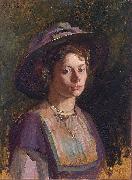 |
Heinrich Martin Krabbe -- Click Here
|
|
painted Young Lady in 19th/20th century
|
|
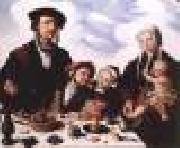 |
HEEMSKERCK, Maerten van -- Click Here
|
|
Netherlandish painter (b. 1498, Heemskerck, d. 1574,
Haarlem). |
|
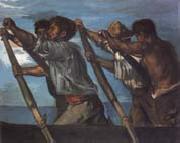 |
Hans von Maress -- Click Here
|
|
1837 Elberfeld-1887 Rome |
|
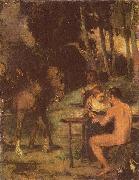 |
Hans von Marees -- Click Here
|
|
(24 December 1837 - 5 June 1887) was a German painter. He mainly painted country scenes in a realistic style.
Von Marees was born in Elberfeld, Germany. At age 16, he was sent to the Berlin Academy. In 1857, he moved to Munich.
In 1869, he visited France, the Netherlands and Spain. He served in the Franco-Prussian War (1870-71) and then lived in Berlin and Dresden for a while. In 1873, he decorated the library walls of the newly built Naples Zoological Institute in Italy. The next year, he moved to Florence.
He died in Rome at the age of 49 and is buried in the Protestant Cemetery there.
|
|
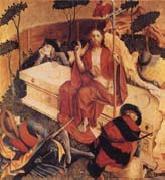 |
Hans Multscher -- Click Here
|
|
German Northern Renaissance Sculptor, ca.1400-1467
German sculptor. Multscher mentions his birthplace on the inscribed band, originally a predella, of the Karg altarpiece in Ulm Cathedral (1433) and on two wings of the so-called 'Wurzach Altar' (1437) at Reichenhofen in the Allgeu. The town archives of Leutkirch, written between 1405 and 1437, record that Multscher belonged to the 'Freien Leute auf Leutkircher Heide', a commune of free peasants who had been able to preserve their independence because they were the direct descendants of Kenigsfreie, who had always been free. Under a charter of Emperor Ludwig in 1337 |
|
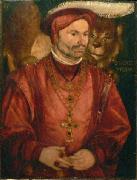 |
Hans Muelich -- Click Here
|
|
painted Court Jester Mertl, Munich in 1545 |
|
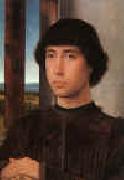 |
Hans Memling -- Click Here
|
|
Netherlandish Northern Renaissance Painter, ca.1435-1494
Born in Seligenstadt, near Frankfurt in the Middle Rhein region, it is believed that Memling served his apprenticeship at Mainz or Cologne, and later worked in the Netherlands under Rogier van der Weyden (c. 1455?C1460). He then went to Bruges around 1465.
There is an apocryphical story that he was a wounded at the Battle of Nancy, sheltered and cured by the Hospitallers at Bruges, and that to show his gratitude he refused payment for a picture he had painted for them. Memling did indeed paint for the Hospitallers, but he painted several pictures for them, in 1479 and 1480, and it is likely that he was known to his patrons of St John, prior to the Battle of Nancy.
Memling is connected with military operations only in a distant sense. His name appears on a list of subscribers to the loan which was raised by Maximilian I of Austria, to defend against hostilities towards France in 1480. In 1477, when he was incorrectly claimed to have been killed, he was under contract to create an altarpiece for the gild-chapel of the booksellers of Bruges. This altarpiece, under the name of the Seven Griefs of Mary, is now in the Gallery of Turin. It is one of the fine creations of his more mature period. It is not inferior in any way to those of 1479 in the hospital of St. John, which for their part are hardly less interesting as illustrative of the master's power than The Last Judgment which can be found since the 1470s in the St. Mary's Church, Gda??sk. Critical opinion has been unanimous in assigning this altarpiece to Memling. This affirms that Memling was a resident and a skilled artist at Bruges in 1473; for the Last Judgment was undoubtedly painted and sold to a merchant at Bruges, who shipped it there on board of a vessel bound to the Mediterranean, which was captured by Danzig privateer Paul Beneke in that very year. This purchase of his pictures by an agent of the Medici demonstrates that he had a considerable reputation. |
|
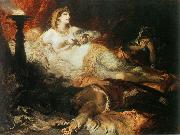 |
Hans Makart -- Click Here
|
|
(May 28, 1840 - October 3, 1884) was a 19th century Austrian academic history painter, designer, and decorator; most well known for his influence on Gustav Klimt and other Austrian artists, but in his own era considered an important artist himself and was a celebrity figure in the high culture of Vienna, attended with almost cult-like adulation.
Makart was the son of a chamberlain at the Mirabell Palace, born in the former residence of the prince-archbishops of Salzburg. Initially, he received his training in painting at the Vienna Academy between 1850 and 1851 from Johann Fischbach. While in the Academy, German art was under the rule of a classicism, which was entirely intellectual and academice clear and precise drawing, sculpturesque modelling, and pictorial erudition were esteemed above all. Makart, who was a poor draughtsman, but who had a passionate and sensual love of color, was impatient to escape the routine of art school drawing. For his fortune, he was found by his instructors to be devoid of all talent and forced to leave the Vienna Academy.
He went to Munich, and after two years of independent study attracted the attention of Karl Theodor von Piloty, under whose guidance, between 1861 and 1865 he developed his painting style. During these years, Makart also travelled to London, Paris and Rome to further his studies. The first picture he painted under Piloty, Lavoisier in Prison, though it was considered timid and conventional, attracted attention by its sense of color.
In his next work, The Knight and the Water Nymphs, he first displayed the decorative qualities to which he afterwards sacrificed everything else in his work. His fame became established in the next year, with two works, Modern Amoretti and The Plague in Florence. His painting Romeo and Juliet was soon after bought by the Austrian emperor for the Vienna Museum, and Makart was invited to come to Vienna by the aristocracy.
The prince Von Hohenlohe provided Makart with an old foundry at the Gusshausstraße 25 to use as a studio. He gradually turned it into an impressive place full of sculptures, flowers, musical instruments, requisites and jewellery that he used to create classical settings for his portraits, mainly of women. Eventually his studio looked like a salon and became a social meeting point in Vienna. Cosima Wagner described it as a "wonder of decorative beauty, a sublime lumber-room". His luxurious studio served as a model for a great many upper middle-class living rooms.
The opulent, semi-public spaces of the Makart atelier were the scene of a recurring rendezvous between the artist and his public. The artist became the mediator between different levels of society: he created a socially ambiguous sphere in which nobility and bourgeoisie could encounter one another in mutual veneration of the master, and aestheticized the burgeoning self-awareness of the bourgeoisie by means of historical models drawn from the world of the aristocracy. In this way, an artist like Makart lived out the image that high society had created of him. Makart is considered by many as being the first art star, referred to by contemporaries an "artist prince" (Malerferst) in the tradition of Rubens.
Makart became the acknowledged leader of the artistic life of the Vienna, which in the 1870s passed through a period of feverish activity, the chief results of which are the sumptuously decorated public buildings of the Ringstraße. He not only practised painting, but was also an interior designer, costume designer, furniture designer, and decorator, and his work decorated most of the public spaces of the era. His work engendered the term "Makartstil", or "Makart style", which completely characterized the era.
In 1879, Makart had designed a pageant organised to celebrate the Silver Wedding Anniversary of the Imperial couple, emperor Franz Josef and his wife Elisabeth of Bavaria he designed, single-handed, the costumes, scenic setting, and triumphal cars. This became known as the "Makart-parade", and had given the people of Vienna the chance to dress up in historical costumes and be transported back into the past for a few hours. At the head of the parade was a float for artists, led by Makart on a white horse. His festivals became an institution in Vienna which lasted up until the 1960s. In the same year as the first parade he became a Professor at the Vienna Academy.
Makart's painting The Entry of Charles V into Antwerp caused some controversy, because Charles V was depicted arriving in a procession surrounded by nude virgins; the offense was the mistaken idea that the nudes had no place in the modern scene. In the United States, the painting fell under the proscription of Anthony Comstock, which secured Makart's fame there. The American public desired at once to see what Comstock was persecuting, so they could tell whether he was acting correctly or in error.
Salzburg's Makart Square, or Makartplatz, was named after the painter.
|
|
 |
Hanna Mehls -- Click Here
|
|
painted Blumenstillleben in 1900 |
|
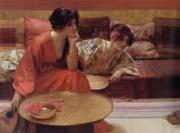 |
H.Siddons Mowbray -- Click Here
|
|
American Painter, 1858-1928 |
|
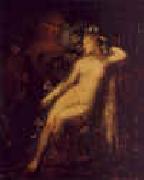 |
Gustave Moreau -- Click Here
|
|
French
1826-1898
Moreau's main focus was the illustration of biblical and mythological figures. As a painter of literary ideas rather than visual images, he appealed to the imaginations of some Symbolist writers and artists, who saw him as a precursor to their movement.
His father, Louis Jean Marie Moreau, was an architect, who recognized his talent. His mother was Adele Pauline des Moutiers. Moreau studied under François-Édouard Picot and became a friend of Th??odore Chass??riau, whose work strongly influenced his own. Moreau carried on a deeply personal 25-year relationship, possibly romantic, with Adelaide-Alexandrine Dureux, a woman whom he drew several times.[1] His first painting was a Piet?? which is now located in the cathedral at Angoul??me. He showed A Scene from the Song of Songs and The Death of Darius in the Salon of 1853. In 1853 he contributed Athenians with the Minotaur and Moses Putting Off his Sandals within Sight of the Promised Land to the Great Exhibition.
Oedipus and the Sphinx, one of his first symbolist paintings, was exhibited at the Salon of 1864. Over his lifetime, he produced over 8,000 paintings, watercolors and drawings, many of which are on display in Paris' Mus??e national Gustave Moreau at 14, rue de la Rochefoucauld (IXe arrondissement). The museum is in his former workshop, and was opened to the public in 1903. Andr?? Breton famously used to "haunt" the museum and regarded Moreau as a precursor to Surrealism.
He had become a professor at Paris' École des Beaux-Arts in 1891 and counted among his many students the fauvist painters, Henri Matisse and Georges Rouault.
Moreau is buried in Paris' Cimeti??re de Montmartre.
In Alan Moore's graphic novel, The League of Extraordinary Gentlemen, it is implied that he was a nephew of Doctor Moreau, and he based a few of his paintings on the Doctor's creations. |
|
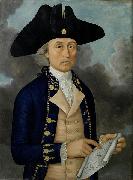 |
Guan Zuolin of Macao -- Click Here
|
|
painted Portrait of Captain Joseph Huddart in c. 1785 |
|
 |
Grunewald, Matthias -- Click Here
|
|
German Northern Renaissance Painter, ca.1470-1528
.the traditional name of a painter whose real name is believed to have been Nithardt or Neithardt. He was active at Isenheim nr. Colmar c.1514 and in Frankfurt c.1526. Gr??newald's principal work, an elaborate altarpiece of many panels painted for the monastery at Isenheim (Isenheimer Altar), is now in the Colmar museum. |
|
 |
GIUSTO de Menabuoi -- Click Here
|
|
Italian painter, Florentine school (b. ca. 1320, Firenze, d. 1391,
Italian painter, Florentine school (b. ca. 1320, Firenze, d. 1391, was an Italian painter of the early Renaissance. He was born in Florence. In Lombardy he executed a fresco of the Last Judgement in the Abbey of Viboldone, Milan. He then moved to Padua where he completed frescos in the Church of the Eremitani, the Basilica of Saint Anthony of Padua and most notably, the Baptistery of the Duomo (1376). |
|
 |
Giuseppe Maria Terreni -- Click Here
|
|
Italian , (1739-1811) |
|
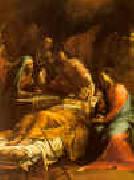 |
Giuseppe Maria Crespi -- Click Here
|
|
1665-1747
Italian
Giuseppe Maria Crespi Locations
1747). Painter, draughtsman and printmaker. His religious and mythological works are distinguished by a free brushstroke and a painterly manner. He also painted spirited genre scenes, which by their quality, content and quantity distinguish him as one of the first Italian painters of high standing to devote serious attention to the depiction of contemporary life. Such paintings as Woman Laundering (1700-05; St Petersburg, Hermitage) or Woman Washing Dishes (1720-25; Florence, Uffizi) offer straightforward glimpses of domestic chores in images that are startlingly novel for the period and look forward to the art of Jean-Simeon Chardin, Jean-Francois Millet and Honore Daumier |
|
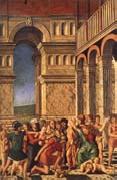 |
Girolamo Mocetto -- Click Here
|
|
Italian Painter, ca.1470-1531,Italian engraver, painter and designer of stained glass. He was born into a family of glass painters, and, although there is no documentary evidence that he worked outside Venice, his early paintings and engravings show the influence of Domenico Morone and of Mantegna and his circle, which would suggest that Mocetto's training may not have been exclusively Venetian. His artistic evolution is most clearly seen in a comparison of early works still close to Morone, such as a series of three engravings of the Battle between Israel and the Amalekites (see Hind, nos 719-20) or the painting of the Battle (Pavia, Pin. Malaspina), to works of a few years later, such as the two small paintings of the Massacre of the Innocents (London, N.G.; see fig.) and the engravings of Pagan Sacrifices (H 726-7), the Metamorphosis of Amymone (H 728) and the Calumny of Apelles (H. 727), all datable to c. 1500. In the later works, whole passages or motifs are copied or adapted from drawings and engravings by Mantegna. Mocetto may have had direct contact with the court of Mantua (the Metamorphosis of Amymone is an allegory of the city of Mantua); two engravings dating from the first years of the 16th century, St John the Baptist (H 724) and Judith with the Head of Holofernes (H 725), |
|
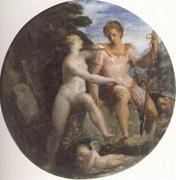 |
Girolamo Macchietti -- Click Here
|
|
Italian Painter , Firenze1535-1592
was an Italian painter active in Florence, working in a Mannerist style. He was a pupil of Michele di Ridolfi. During 1556-62, worked as an assistant to Giorgio Vasari in the decoration of the Palazzo Vecchio, where he worked with Mirabello Cavalori. He participated in the Vasari-directed decoration of the Studiolo of Francesco I with two canvases, one relating a Jason and Medea (1570) and the other a Baths of Pozzuoli (1572). He also painted an altarpiece on the Martyrdom of Saint Lawrence for Santa Maria Novella. In 1577, he completed a Gloria di San Lorenzo for Empoli Cathedral. He traveled to Rome and spent two years in Spain (1587-1589). |
|
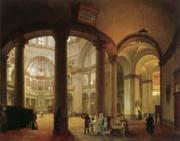 |
Giovanni Migliara -- Click Here
|
|
Italian 1785-1837
He began his career as a scene painter with Gaspare Galiari (1761-1823) in Milan, working at the Teatro Carcano in 1804 and at La Scala from 1805 to 1809. Owing to illness, after 1810 he turned to small-scale works in watercolour or oil using various supports, including silk and ivory. At this date Milanese painting was dominated by Andrea Appiani and Luigi Sabatelli, both leading Neo-classical artists. However, Migliara remained aloof from this dominant movement and instead drew on medieval and historical subjects with Romantic undertones. His precise, jewel-like technique and choice of subject-matter found favour with aristocratic patrons in Milan. His figures are generally stilted and burdened by their costumes, though the crowd in Sacking of Minister Prina's House (1814; Milan, Gal. A. Mod.) is depicted with unusual fluency. In 1822 Migliara was appointed Professor of Perspective at the Accademia di Belle Arti, Milan, and in 1833 he was nominated painter to the court of Charles-Albert, King of Sardinia (reg 1831-49). More typical of his historical scenes is Entrance to the Castle of Plessis de la Tour (Turin, Gal. Civ. A. Mod.), which was exhibited at the Brera in 1833. He also produced many topographically precise pictures of church interiors in which he combined his training as a scene painter with his knowledge of intaglio techniques. |
|
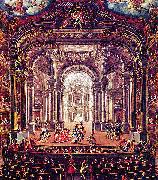 |
Giovanni Michele Graneri -- Click Here
|
|
painted The Teatro Regio in Turin in 1752 |
|
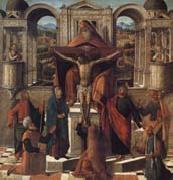 |
Giovanni Mansueti -- Click Here
|
|
Italian Early Renaissance Painter, active 1484-ca.1526, was an Italian painter. Also known as Giovanni Mansueti. Known by a few paintings. Little is known of his biography. He was active in Venice from 1485 to 1526. Pupil of Gentile Bellini and worked in the antique style in the Miracles of the Cross painted in 1494- c. 1502 for the Scuola di san Giovanni Evangelista and now in the Gallerie dell'Accademia. In style he resembles Cima da Conegliano and Vittore Carpaccio. One of his paintings resides in a church near Bagni di Luca, Italy. |
|
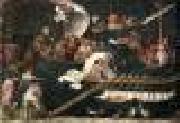 |
GIOVANNI DA MODENA -- Click Here
|
|
Italian painter, Bolognese school (active 1409-1456 in Bologna) |
|
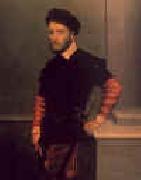 |
Giovanni Battista Moroni -- Click Here
|
|
Italian
c1520-1578
was a North Italian painter of the Late Renaissance period. He is also called Giambattista Moroni. Best known for his elegantly realistic portraits of the local nobility and clergy, he is considered one of the great portrait painters of sixteenth century Italy.
The National Gallery (London) has one of the best collections of his work, including the celebrated portrait known as Il Sarto (The Tailor, a member of the Fenaroli family, illustration). Other portraits are found in the Uffizi (the Nobleman Pointing to Flame inscribed "Et quid volo nisi ut ardeat?"), Berlin Gallery, the Canon Ludovico de' Terzi and Moroni's self-portrait; and in the National Gallery, Washington, the seated half-figure of the Jesuit Ercole Tasso, traditionally called "Titian's Schoolmaster", although there is no real connection with Titian.
The Accademia Carrara (Bergamo) (Portrait of an old man). Ashmolean Museum (University of Oxford), Brooks Museum of Art (Memphis, Tennessee), Detroit Institute of Arts, the Fine Arts Museums of San Francisco, the Hermitage Museum, the Honolulu Academy of Arts, Kunsthistorisches Museum (Vienna), the Liechtenstein Museum (Vienna), the Musee du Louvre, Mus??e Cond?? Chantilly (Chantilly, France), Museo Poldi Pezzoli (Milan), the Museum of Fine Arts, Boston, National Galleries of Scotland, the National Gallery of Art (Washington D.C.), the National Gallery of Australia, the National Gallery of Canada, the National Gallery, London, the Norton Simon Museum (Pasadena, California), Pinacoteca Ambrosiana (Milan), Pinacoteca di Brera (Milan), Rijksmuseum, the Ringling Museum of Art (Florida), Studio Esseci (Padua, Italy), University of Arizona Museum of Art, Virginia Museum of Fine Arts and the Uffizi (Portrait of Giovanni Antonio Pantera) are among the public collections holding works by Giovanni Battista Moroni. |
|
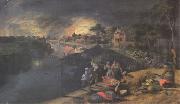 |
Gillis Mostraert -- Click Here
|
|
Hulst 1534-Antwerp after 1598 |
|
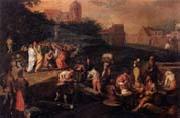 |
Gillis Mostaert -- Click Here
|
|
Flemish Northern Renaissance Painter ,
b. ca. 1534, Hulst, d. 1598, Antwerp |
|
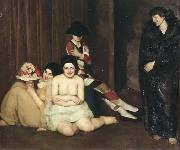 |
Gian Emilio Malerba -- Click Here
|
|
(1880 -1926 ) - Painter |
|
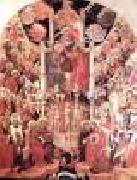 |
GIAMBONO, Michele -- Click Here
|
|
Italian painter, Venetian school (known 1420-1462 in Venice) |
|
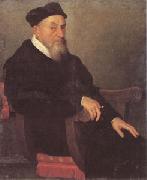 |
Giambattista Moroni -- Click Here
|
|
Albino(near Bergamo 1520/25-Bergamo 1578
Italian painter. He was the most significant painter of the 16th-century school of Bergamo and is best known for his portraits, which feature a naturalistic rendering of both faces and costume and an objective approach to character. |
|
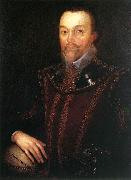 |
GHEERAERTS, Marcus the Younger -- Click Here
|
|
Flemish Baroque Era Painter, ca.1561-1636
was an artist of the Tudor court, described as "the most important artist of quality to work in England in large-scale between Eworth and Van Dyck" He was brought to England as a child by his father Marcus Gheeraerts the Elder, also a painter. He became a fashionable portraitist in the last decade of the reign of Elizabeth I under the patronage of her champion and pageant-master Sir Henry Lee, introducing a new aesthetic in English court painting that captured the essence of a sitter through close observation. He became a favorite portraitist of James I's queen Anne of Denmark, but fell out of fashion in the later 1610s. Marcus Gheeraerts the Younger was the son of the artist Marcus Gheeraerts the Elder and his wife Johanna. Hardly anything is known of the paintings of the elder Gheeraerts, although his work as a printmaker reached around Europe. Like other Protestant artists, Gheeraerts the Elder fled to England with his son to escape persecution in the Netherlands under the Duke of Alva. His wife was a Catholic and remained behind; she is assumed to have died a few years later. Father and son are recorded living with a Dutch servant in the London parish of St Mary Abchurch in 1568. On 9 September 1571, the elder Gheeraerts remarried. His new wife was Susanna de Critz, a member of an exiled family from Antwerp. It is uncertain by whom young Marcus was trained, although it is likely to have been his father; he was possibly also a pupil of Lucas de Heere. Records suggest that Marcus was active as a painter by 1586 In 1590 he married Magdalena, the sister of his stepmother Susanna and of the painter John de Critz. |
|
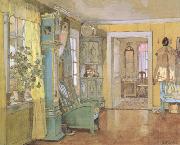 |
Gerhard Munthe -- Click Here
|
|
1849 (1929)
was a Norwegian painter and illustrator.Munthe was born in Elverum to physician Christopher Pavels Munthe (1816 C 1884) and his wife Christine Margrethe Pavels Aabel (1827 C 1887). He was a brother of historian and military officer Hartvig Andreas Munthe, writer Margrethe Munthe and military officer Carl Oscar Munthe. He was also an nephew of historian and cartographer Gerhard Munthe and an uncle of genealogist Christopher Morgenstierne Munthe, librarian Wilhelm Munthe and painter Lagertha Munthe. Through his mother he was a nephew of Andreas Leigh Aabel and Oluf Andreas Aabel, and a first cousin of Hauk Aabel. In December 1886 he married Sigrun Sandberg (1869 C 1957). Between 1886 and 1890 Bjørn Bjørnson was his stepfather-in-law. Munthe and Sandberg settled in Sandvika and later Lysaker. Also, Munthe had a studio at Ringstabekk for a short period.The couple divorced in 1919, the same year she married Fridtjof Nansen. |
|
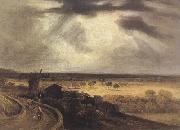 |
Georges Michel -- Click Here
|
|
French Painter, 1763-1843
French painter. He came from a humble background, his father being an employee at the market of Les Halles in Paris. At an early age, a farmer general, M. de Chalue, took an interest in him and found him a place with the curate of Veruts, on the plain of Saint-Denis, north of Paris. It was here that he first developed a love of the countryside. In 1775 he was apprenticed to a mediocre history painter called Leduc, but he preferred to go off and sketch out of doors. In order to assist him, M. de Berchigny, Colonel in the Hussars, engaged him in his regiment garrisoned in Normandy and arranged for him to take lessons in art. He remained there for more than a year and then returned to Paris, where he worked with M. de Grammont-Voulgy, who was Steward to the brother of Louis XVI. |
|
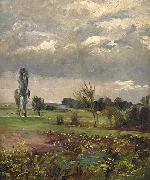 |
George Mosson -- Click Here
|
|
George Mason IV (December 11, 1725 - October 7, 1792) was an American Patriot, statesman and a delegate from Virginia to the U.S. Constitutional Convention. Along with James Madison, he is called the "Father of the Bill of Rights."[1][2][3][4] For these reasons he is considered one of the "Founding Fathers" of the United States.[5][6]
Like anti-federalist Patrick Henry, Mason was a leader of those who pressed for the addition of explicit States rights[7] and individual rights to the U.S. Constitution as a balance to the increased federal powers, and did not sign the document in part because it lacked such a statement. His efforts eventually succeeded in convincing the Federalists to add the first ten amendments of the Constitution. These amendments, collectively known as the Bill of Rights, were based on the earlier Virginia Declaration of Rights, which Mason had drafted in 1776.
On the nagging issue of slavery, Mason walked a fine line. Although a slaveholder himself, he found slavery repugnant for a variety of reasons. He wanted to ban further importation of slaves from Africa and prevent slavery from spreading to more states. However, he did not want the new federal government to attempt to ban slavery where it already existed, because he anticipated that such an act would be difficult and controversial.
|
|
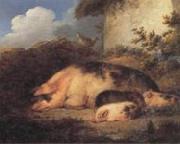 |
George Morland -- Click Here
|
|
English genre, animal, and landscape painter, 1763-1804
was an English painter of animals and rustic scenes. Morland was born in London on 26 June 1763. His mother was a Frenchwoman, who possessed a small independent property of her own. His grandfather, George H. Morland, was a subject painter. Henry Robert Morland (c. 1719 ?C 1797), father of George, was also an artist and engraver, and picture restorer, at one time a rich man, but later in reduced circumstances. His pictures of Jaundry-maids, reproduced in mezzotint and representing ladies of some importance, were very popular in their time. At a very early age Morland produced sketches of remarkable promise, exhibiting some at the Royal Academy in 1773, when he was but ten years old, and continuing to exhibit at the Free Society of Artists in 1775 and 1776, and at the Society of Artists in 1777, and then sending again to the Royal Academy in 1778, 1779 and 1780. His very earliest work, however, was produced even before that tender age, as his father kept a drawing which the boy had executed when he was but four years old, representing a coach and horses and two footmen. He was a student at the Royal Academy in early youth, but only for a very short time. From the age of fourteen he was apprenticed to his father for seven years, and by means of his talent appears to have kept the family together. He had opportunities at this time of seeing some of the greatest artists of the day, and works by old masters, but even then a strange repugnance for educated society showed itself, and no persuasion |
|
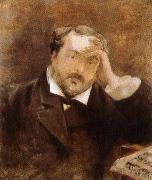 |
george moore -- Click Here
|
|
(1873 C 1958), G.E. Moore, British philosopher |
|
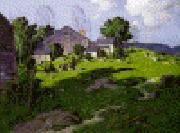 |
George M Bruestle -- Click Here
|
|
1872-1939
George M Bruestle Gallery |
|
|
|
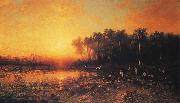 |
George Herbert McCord -- Click Here
|
|
(1848 -1909 ) - Painter
|
|
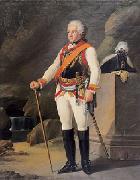 |
Georg Melchior Kraus -- Click Here
|
|
(26 July 1737, Frankfurt am Main - 5 November 1806, Weimar) was a German painter. A student of Johann Heinrich Tischbein, he was also a teacher himself (his pupils included Ferdinand Jagemann), as well as an entrepreneur and friend of Goethe. He was a co-founder of the Ferstliche freie Zeichenschule Weimar with Friedrich Justin Bertuch in 1776.
|
|
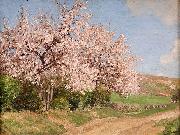 |
Georg Macco -- Click Here
|
|
Germany (1863- 1933 ) - Painter |
|
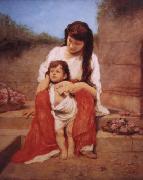 |
Gabriel von Max -- Click Here
|
|
(August 23, 1840 - November 24, 1915) was a Prague-born Austrian painter.
He was born Gabriel Cornelius Max, the son of Czech sculptor Joseph Max and Anna Schumann. He studied between 1855 and 1858 at the Prague Academy of Arts with Eduard von Engerth. His studies included parapsychology (somnambulism, hypnotism, spiritism), Darwinism, Asiatic philosophy, the ideas of Schopenhauer, and various mystical traditions. The spiritual-mystical movement was emphasized by the writings of Carl du Prel, and the Munich painter Albert Keller was also an influence.
His first large canvas was painted in 1858 while he was a student at the Prague Academy. He continued his studies at the Viennese Academy of Art with Karl von Blaas, Karl Mayer, Christian Ruben and Carl Wurzinger. From 1863 to 1867 he studied at the Munich Academy with Karl Theodor von Piloty, and also Hans Makart and Franz Defregger. His first critical success was in 1867 with the painting "Martyr at the Cross": that painting transformed the "Ungl?-ksmalerei" (dark palette) of Piloty into a religious-mystical symbolism using a psychological rendering of its subject.
He continued to use the dark palette of the Piloty school well into the 1870s, later moving toward a more muted palette, using fewer,clearer colors. From 1869, Gabriel von Max had his studio in Munich; in the summer, he was in the Ammerland at Starnberger Lake. From 1879-1883, Gabriel Max was a professor of Historical Painting at the Munich Academy; he also became a Fellow of The Theosophical Society. In 1900 he was ennobled and became a Ritter. He died in Munich in 1915.
His interest in anthropological studies also showed in his work. He owned a large scientific collection of prehistoric ethnological and anthropological finds: the collection now resides in the Stadtischen Reiss Museum in Mannheim. At his residence in Starnberger Lake, Gabriel Max surrounded himself with a family of monkeys, which he painted often, sometimes portraying them as human. Max, along with his colleagues, often used photographs to guide painting. The great number of monkey photographs in his archive testify to their use as direct translation into his paintings. In 1908, his painting "The Lion's Bride" became celebrated, and was depicted in motion pictures as an hommage in the Gloria Swanson film, Male and Female, (1919), directed by Cecil B. de Mille.
Gabriel von Max was a significant artist to emerge from the Piloty School, because he abandoned the themes of the Grunderzeitliche (genre and history), in order to develop an allegorical-mystical pictorial language, which became typical of Secessionist Art. Characteristic of the ethereal style of Gabriel Max is "The Last Token" (in the Metropolitan Museum), and "Light" (in the Odessa Museum of Western and Eastern Art, Ukraine).
|
|
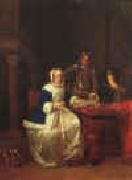 |
Gabriel Metsu -- Click Here
|
|
1629-1667
Dutch
Gabriel Metsu Galleries
One of his earliest pictures is the "Lazarus" at the Strassburg Museum, painted under the influence of Jan Steen. In 1653 under the influence of Rembrandt he painted "Woman taken in Adultery," a large picture which is now in the Louvre. To the same period belong the "Departure of Hagar," formerly in the Thore collection, and the "Widow's Mite" at the Schwerin Gallery. But he probably observed that sacred art was ill suited to his temper, or he found the field too strongly occupied, and turned to other subjects for which he was better fitted. That at one time he was deeply impressed by the vivacity and bold technique of Frans Hals can be gathered from Lord Lonsdale's picture of "Women at a Fishmonger's Shop."
What Metsu undertook and carried out from the first with surprising success was the low life of the market and tavern, contrasted, with wonderful versatility, by incidents of high life and the drawing-room. In no single instance do the artistic lessons of Rembrandt appear to have been lost upon him. The same principles of light and shade which had marked his schoolwork in the "Woman taken in Adultery" were applied to subjects of quite a different kind. A group in a drawing-room, a series of groups in the market-place, or a single figure in the gloom of a tavern or parlour, was treated with the utmost felicity by fit concentration and gradation of light, a warm flush of tone pervading every part, and, with that, the study of texture in stuffs was carried as far as it had been by Ter Borch or Gerard Dou, if not with the finish or the brio of De Hooch.
One of the best pictures of Metsu's manhood is the "Market-place of Amsterdam," at the Louvre, respecting which it is difficult to distribute praise in fair proportions, so excellent are the various parts, the characteristic movement and action of the dramatis personae, the selection of faces, the expression and the gesture, and the texture of the things depicted. Equally fine, though earlier, are the "Sportsman" (dated 1661) and the "Tavern" (also 1661) at the Hague and Dresden Museums, and the "Game-Dealer's Shop," also at Dresden, with the painter's signature and 1662.
Gabriel Metsu, Man Writing a Letter (1662-1665), Oil on canvas, National Gallery of Ireland, DublinAmong the five examples of the painter in the Wallace Collection, are "The Tabby Cat," and "The Sleeping Sportsman," which cost Lord Hertford £ 3000, is an admirable example technically considered. Among his finest representations of home life are the "Repast" at the Hermitage in St Petersburg; the "Mother nursing her Sick Child" in the Rijksmuseum in Amsterdam; the "Amateur Musicians" at the Hague Gallery; the "Duet" and the "Music Lesson" at the National Gallery, London, and many more examples at nearly all the leading European galleries. Five of his painting are in Dresden, collected by August the Strong. |
|
 |
Gabriel Metsu -- Click Here
|
|
Gabriël Metsu
Gabriël Metsu (January 1629 - buried 24 October 1667) was a Dutch painter of history paintings, genre works and portraits.
Metsu was the son of the Flemish painter Jacques Metsu (c.1588-1629), who lived most of his days at Leiden, and Jacomijntje Garniers, his third wife, whom he married in 1625. Jacomijntje was the widow of a painter with three children of her own. Two months after Gabriël's birth, his father died.
According to Jacobus Houbraken, Metsu was taught by Gerard Dou, though his early works do not lend colour to this assertion. He was influenced by painters of Leiden such as Jan Steen, and later by Frans van Mieris the Elder.
Metsu was registered among the first members of the painters' corporation at Leiden; and the books of the guild also tell us that he remained a member in 1649. In Leiden, it was alleged that Metsu left a brothel at six in the morning and took a prostitute to the Academy. In 1650 he ceased to subscribe, and works bearing his name and the date of 1653 support the belief that he had moved. Metsu was trained in Utrecht by Jan Baptist Weenix and Nicolaus Knepfer.
In Amsterdam Metsu lived in an alley on Prinsengracht, where he kept chickens. He got into an argument with a neighbor and moved to a house on the canal side, where a daily vegetable market was held. In 1658 he married Isabella de Wolff, whose father was a potter and mother a painter. The Speed Art Museum has a portrait of the couple. Pieter de Grebber, a religious painter from Haarlem, was her uncle.
At the onset of the 1660s Metsu turned for inspiration to the art of the "fijnschilders" from his native Leiden. Metsu was responding to the market of Dou's paintings, who sold his paintings all over for exorbitant prices. Metsu may have also influenced Pieter de Hoogh. Around the year 1661, Metsu won the patronage of the Amsterdam cloth merchant Jan J. Hinlopen and painted his family more than once in a fashionable surrounding.
The Poultry-Seller, 1662
At least thirteen of paintings show carpets and he probably used the same model. He included several fine examples of minutely depicted floral and cloudband carpets in his works and even a silk Oriental rug, as well as so-called "Lotto" rugs which he for some reason, in contrast to his meticulous rendering of the floral carpets, depicted only in a very sketchy fashion. After Metsu died, his widow left for Enkhuizen, to live with her mother. |
|
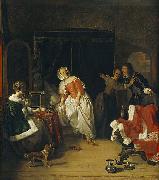 |
Gabrie Metsu -- Click Here
|
|
Gabriël Metsu (January 1629 - buried 24 October 1667) was a Dutch painter of history paintings, genre works and portraits.
Metsu was the son of the Flemish painter Jacques Metsu (c.1588-1629), who lived most of his days at Leiden, and Jacomijntje Garniers, his third wife, whom he married in 1625. Jacomijntje was the widow of a painter with three children of her own. Two months after Gabriël's birth, his father died.
According to Jacobus Houbraken, Metsu was taught by Gerard Dou, though his early works do not lend colour to this assertion. He was influenced by painters of Leiden such as Jan Steen, and later by Frans van Mieris the Elder.
Metsu was registered among the first members of the painters' corporation at Leiden; and the books of the guild also tell us that he remained a member in 1649. In Leiden, it was alleged that Metsu left a brothel at six in the morning and took a prostitute to the Academy. In 1650 he ceased to subscribe, and works bearing his name and the date of 1653 support the belief that he had moved. Metsu was trained in Utrecht by Jan Baptist Weenix and Nicolaus Knepfer.
The alley on Prinsengracht
In Amsterdam Metsu lived in an alley on Prinsengracht, where he kept chickens. He got into an argument with a neighbor and moved to a house on the canal side, where a daily vegetable market was held. In 1658 he married Isabella de Wolff, whose father was a potter and mother a painter. The Speed Art Museum has a portrait of the couple. Pieter de Grebber, a religious painter from Haarlem, was her uncle.
|
|
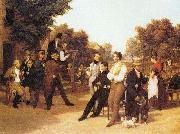 |
Friedrich Eduard Meyerheim -- Click Here
|
|
painted Die Kegelgesellschaft in 1834 |
|
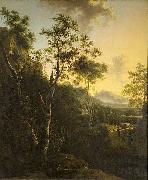 |
Frederik de Moucheron -- Click Here
|
|
(1633-2 January 1686) was a Dutch Golden Age landscape painter.
Frederik de Moucheron was the son of the painter Balthazar de Moucheron and Cornelia van Brouckhoven. His father came from a wealthy family of wine traders and is portrayed as one of the younger sons in the Moucheron Family portrait, 1563. Frederik trained with Jan Asselijn and became a landscape painter. He set off at age 22 for Paris, where he spent 3 years and then after a tour of Antwerp, Paris. and Lyon, he settled in 1659 in Amsterdam. In the same year he married Mariecke de Jouderville there and they had 11 children. He is buried in Amsterdam.
He painted French, Italian, and Dutch landscapes. To finish these scenes, contemporaries specialized in painting figures collaborated with him, such as Adriaen van de Velde in Amsterdam, Theodor Helmbreker in Paris, and at times Johannes Lingelbach, and Nicolaes Pieterszoon Berchem.
|
|
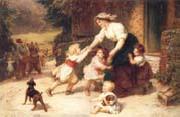 |
Frederick Morgan -- Click Here
|
|
English Painter 1856-1927
|
|
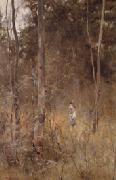 |
Frederick Mccubbin -- Click Here
|
|
Australian Painter, 1855-1917
By the early 1880s, his work began to attract considerable attention and won a number of prizes from the National Gallery, including a 30-pound first prize in 1883 in their annual student exhibition, and by the mid-1880s began to concentrate more on the works of the Australian bush which made him most famous. In 1883, he received first prize in the first annual Gallery students' exhibition, for best studies in colour and drawing. In 1888, he became instructor and master of the School of Design at the National Gallery. In this position he taught a number of students who themselves became prominent Australian artists, including Charles Conder and Arthur Streeton. He continued to paint through the first two decades of the 20th century, though by the beginning of World War I his health began to fail. He travelled to England in 1907 and visited Tasmania, but aside from these relatively short excursions lived most of his life in Melbourne. McCubbin married Annie Moriarty in March, 1889. They had seven children, of whom their son Louis also became an artist. In 1901 McCubbin and his family moved to Mount Macedon, where he was inspired by the surrounding bush and has experimented with the light and its effects on colour in nature. In 1912, |
|
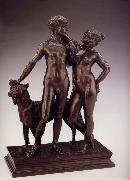 |
Frederick Macmonnies -- Click Here
|
|
American Sculpture 1863-1937,American sculptor and painter. During his apprenticeship in New York (1880-84) with Augustus Saint-Gaudens, who discovered and encouraged his talent, he rose from menial helper to assistant, studying in the evenings at Cooper Union and the National Academy of Design. Through Saint-Gaudens he met two architects who later became invaluable colleagues: Stanford White and Charles F. McKim, who lent him money in 1884 to go to Paris. He studied drawing at Colarossi's then went to Munich, attending drawing and portrait classes at the Akademie (1884-5) and worked for Saint-Gaudens again (1885-6). In Paris he studied sculpture with Alexandre Falguiere at the Ecole des Beaux-Arts, |
|
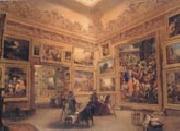 |
Frederick Mackenzie -- Click Here
|
|
watercolour painter and architectural draughtsman ,
ca.1787-1854 |
|
|
|
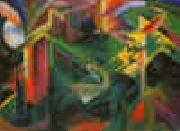 |
Franz Marc -- Click Here
|
|
1880-1916 German
Franz Marc Locations
Franz Marc was born in 1880, in the German town of Munich. His father, Wilhelm, was a professional landscape painter, and his mother Sophie was a strict Calvinist. He began study at the Academy of Fine Arts, Munich in 1900. In 1903 and 1907 he spent time in Paris and discovered a strong affinity for the work of Vincent van Gogh. Marc developed an important friendship with the artist August Macke in 1910. In 1911 he formed the Der Blaue Reiter artist circle with Macke, Wassily Kandinsky, and other artists who decided to split off from the Neue K??nstlervereinigung movement.
He showed several of his works in the first Der Blaue Reiter exhibition at the Thannhauser Galleries in Munich between December 1911 and January 1912. The exhibition was the apex of the German expressionist movement and also showed in Berlin, Köln, Hagen, and Frankfurt. In 1912, Marc also met Robert Delaunay, whose use of color and futurist method was a major influence on Marc's work. Marc became influenced by futurism and cubism, and his art became stark and abstract in nature.
His name was on a list of notable artists to be withdrawn from combat in World War I. Before the orders were carried out, he was struck in the head and killed instantly by a shell splinter during the Battle of Verdun (1916).
|
|
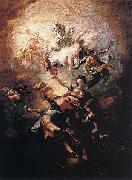 |
Franz Anton Maulbertsch -- Click Here
|
|
(June 7, 1724 -- August 8, 1796) was an Austrian painter and engraver, one of the most renowned exponents of roccoco painting in the German region.
Maulbertsch was born in Langenargen and studied in the Academy of Vienna. Through the knowledge of Paul Troger, he was influenced by the Venetian painters Piazzetta and Giovanni Battista Pittoni. He also studied the frescoes by Sebastiano Ricci in the Schönbrunn Palace in Vienna, and frequented Giambattista Tiepolo, who was active in Werzburg starting from 1750.
An appreciated frescoer, he received numerous commissions, mostly of ecclesiastical theme. He produced art for churches in Bicske, Kalocsa, Vienna's Michaelerkirche and Piaristenkirche Maria Treu. He also decorated the Porta Coeli in Moravia, the Kromeř Archbishop's Palace and the villa of Halbturn.
He also painted a portrait of Narcissus of Jerusalem |
|
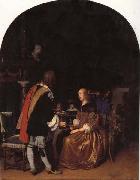 |
Frans van mieris the elder -- Click Here
|
|
Dutch Baroque Era Painter, 1635-1681
was a Dutch genre and portrait painter. The leading member of a Leiden family of painters, his sons Jan (1660-1690) and Willem (1662 C1747) and his grandson Frans van Mieris the Younger (1689 C1763) were also accomplished genre painters. Frans was the son of Jan Bastiaans van Mieris, a goldsmith, carver of rubies and diamond setter at Leiden. His father wished to train him to his own business, but Frans preferred drawing, and took service with Abraham Torenvliet, a glazier who kept a school of design. In his father's shop he became familiar with the ways and dress of people of distinction. His eye was fascinated in turn by the sheen of jewelry and stained glass; and, though he soon gave up the teaching of Torenvliet for that of Gerard Dou and Abraham van den Tempel, he acquired a manner which had more of the finish of the exquisites of the Dutch school than of the breadth of the disciples of Rembrandt. It should be borne in mind that he seldom chose panels of which the size exceeded 12 to 15 inches, and whenever his name is attached to a picture above that size we may surely assign it to his son Willem or to some other imitator. Unlike Dou when he first left Rembrandt, or Jan Steen when he started on an independent career, Mieris never ventured to design figures as large as life. Characteristic of his art in its minute proportions is a shiny brightness and metallic polish. The Music Lesson,National Museum of Serbia , BelgradeThe subjects which he treated best are those in which he illustrated the habits or actions of the wealthier classes; but he sometimes succeeded in homely incidents and in portrait, and not unfrequently he ventured on allegory. He repeatedly painted the satin skirt which Ter Borch brought into fashion, and he often rivalled Ter Borch in the faithful rendering of rich and highly-coloured woven tissues. But he remained below Ter Borch and Metsu, because he had not their delicate perception of harmony or their charming mellowness of touch and tint, and he fell behind Gerard Dou, because he was hard and had not his feeling for effect by concentrated light and shade. In the form of his composition, which sometimes represents the framework of a window enlivened with greenery, and adorned with bas-reliefs within which figures are seen to the waist, his model is certainly Dou. |
|
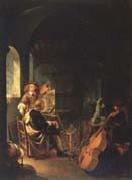 |
Frans van Mieris -- Click Here
|
|
Dutch Baroque Era Painter, 1635-1681 |
|
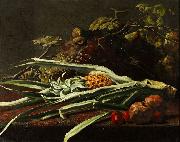 |
Frans Mortelmans -- Click Here
|
|
painted Still life with pineapple, grapes, apples and pomegranates in c. 1882
|
|
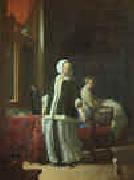 |
Frans Jansz van Mierisi -- Click Here
|
|
1635-1681
Dutch
Frans Jansz van Mierisi Gallery |
|
 |
Frans de Momper -- Click Here
|
|
Flemish Baroque Era Painter, 1603-1660
Painter and draughtsman, nephew of (1) Josse de Momper II. In 1629 he became a master in the Antwerp Guild of St Luke. He left Antwerp for the northern Netherlands, working initially at The Hague; by 1647 he was in Haarlem and the following year Amsterdam, where he married in 1649. In 1650 Frans returned to Antwerp, where he painted numerous monochrome landscapes in the manner of Jan van Goyen. Paintings such as the Valley with Mountains (c. 1640-50; Philadelphia, PA, Mus. A.) prefigure the imaginative landscapes of Hercules Segers. The impression of vast panoramic spaces in Frans's work is adopted from his uncle's art. Frans executed a number of variations on the theme of a river landscape with boats and village (e.g. pen-and-ink drawing, Edinburgh, N.G.). In the late painting Landscape with a Ch?teau Encircled by Doves (Bordeaux, Mus. B.-A.), the low horizon and light-filled sky are adopted from the new Dutch school of tonal landscape painting, while the delicacy of the figures, feathery trees and buildings are features of the Italo-Flemish tradition exemplified by his uncle. Similar qualities of refinement and luminosity characterize the Winter Landscape (c. 1650; Prague, N.G., Sternberk Pal.), |
|
|
|
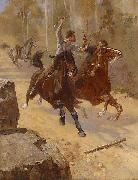 |
Frank Mahony -- Click Here
|
|
(4 December 1862 - 28 June 1916) was an Australian artist and member of the Dawn and Dusk Club.
Although christened "Francis Mahony", he later added 'Prout' and usually signed his work 'Frank P. Mahony'.
Mahony was born in Melbourne, third surviving child of Timothy Mahony, an Irish-born contractor, and his Cornish second wife Elizabeth, Johns. Mahony was taken to Sydney when 10 years old and studied at the Academy of Art under Giulio Anivitti.Mahony's work was accepted by The Bulletin and he became known for his excellent drawings of horses. In 1889 his oil painting Rounding up a Straggler, was bought for the Art Gallery of New South Wales; in 1896 The Cry of the Mothers was also purchased.Mahony did a lot of illustrative work for the Picturesque Atlas of Australia, Victoria and its Metropolis, the Antipodean and other magazines of the period, and was also responsible for some of the illustrations to Barcroft Boake's Where the Dead Men Lie. |
|
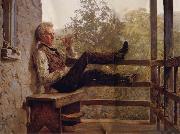 |
Frank Blackwell Mayer -- Click Here
|
|
American Painter, 1827-1899 |
|
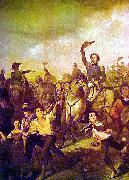 |
Francois-Rene Moreaux -- Click Here
|
|
painted Announcement of Independence in 1844 |
|
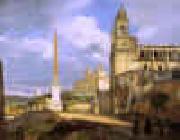 |
Francois-Marius Granet -- Click Here
|
|
1775-1849
French
Francois Marius Granet Gallery
French painter; student of J. L. David. Granet is known for his depictions of church interiors, among them his numerous versions of the Choir of the Capuchin Monastery, one of which is in the Metropolitan Museum. He bequeathed much of his own best work and also his fine collection of paintings to the museum of his native Aix-en-Provence. |
|
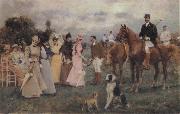 |
Francisco Miralles Y Galup -- Click Here
|
|
Spanish
1848-1901
|
|
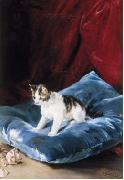 |
Francisco Domingo Marques -- Click Here
|
|
painted Cat in 1842 - 1920 |
|
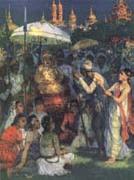 |
Francis Luis Mora -- Click Here
|
|
Uruguayan-born American Painter, 1874-1940 |
|
 |
Francis Davis Millet -- Click Here
|
|
(November 3, 1846 - April 15, 1912) was an American painter, sculptor, and writer who died in the sinking of the RMS Titanic on April 15, 1912.
Francis Davis Millet was born in Mattapoisett, Massachusetts. At age sixteen, Millet entered the Massachusetts regiment, first as a drummer boy and then a surgical assistant in the American Civil War. He repeatedly pointed to his experience working for his father as giving him an appreciation for the vivid blood red that he repeatedly used in his early paintings. |
|
 |
Francesco Morone -- Click Here
|
|
Italian Painter, 1471-ca.1529
was an Italian painter, active in Verona in a Renaissance style. He was the son of the Veronese painter Domenico Morone. The art biographer Vasari praised his frescoes (1505-7) for the cupola of the sacristy in Santa Maria in Organo. He also painted the organ shutters in that church. Paolo Cavazzola was one of his pupils. |
|
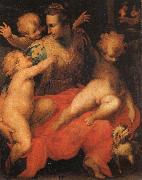 |
Francesco Morandini Da Poppi -- Click Here
|
|
Italian Painter (1544-1597) |
|
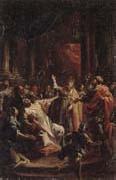 |
Francesco Monti -- Click Here
|
|
Italian Painter, 1685-1768
Italian painter and draughtsman. He was the son of a tailor who served the Este court in Modena during the 1690s. Monti studied with the foremost painter in Modena, Sigismondo Caula (b 1637), for three years from c. 1700. In 1703 he moved to Bologna and entered the studio of Giovanni Gioseffo dal Sole. Roli (1962) defined the formative influences on Monti's art as dal Sole and Donato Creti on the one hand, and Giuseppe Maria Crespi and Antonio Gionima on the other. Monti evolved a distinctive personal idiom, characterized by graceful figures reminiscent of the style of Parmigianino, but perhaps more directly inspired by the more extravagant late Mannerist idiom of such painters as Bartholomeus Spranger and Josef Heintz I of the court of Rudolf II at Prague. Monti may have known their work through prints by Aegidius Sadeler II, Jan Muller and others. This exotic figure style, with fluent, swaying forms and faces suggestively muted by half-shadow was accompanied by unusual shades of colour that glow richly in darkened settings. Monti's art contributed to a neo-Mannerist strain in 18th-century Emilian painting |
|
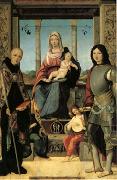 |
Francesco Marmitta -- Click Here
|
|
recorded at Parma 1496-1504 |
|
 |
Francesco Maria Schiaffino -- Click Here
|
|
Italian Rococo Era Sculptor, 1688-1763,Brother of Bernardo Schiaffino. He was the pupil and then assistant of Bernardo, who in 1721 sent him to complete his training in Rome, where he entered the workshop of Camillo Rusconi. He remained there until 1724, enriching his technique and cultural education by studying the works of Bernini, Rusconi and other sculptors. Back in Genoa, he executed such works as St Dominic (Genoa, Teatro Carlo Felice), in which Rusconi's influence is evident. The marble group of Pluto and Proserpine, sculpted for the Durazzo family and still in its original location (Genoa, Pal. Reale), is based on a bozzetto by Rusconi. In 1731 Schiaffino executed the grandiose Crucifix with Angels for King John V of Portugal (Mafra, Convent) and in 1738 began the theatrical funeral monument to Caterina Fieschi Adorno (Genoa, SS Annunziata di Portoria). The wax models of the Eight Apostles and Four Doctors of the Church that he modelled in 1739 (all untraced) were clearly inspired by the large Apostles by Rusconi and other sculptors in S Giovanni in Laterano, Rome. They were made for the stuccoist Diego Francesco Carlone so that he could, under Schiaffino's directions, execute 12 monumental statues in stucco (Genoa, S Maria Assunta in Carignano). In these latter works the classicizing authority of Rusconi's figures was transformed into a freer and more restless arrangement, the compact forms dissolving in the light, animated draperies. The statues reveal how Schiaffino had combined his knowledge of Roman sculpture with his study of Pierre Puget's Genoese works and with the style of the Piola workshop. He emulated the free rhythms of the Rococo found in the painting of Gregorio de' Ferrari, developing a decorative approach that is even more marked in the Assumption of the Virgin (1740; Varazze, S Ambrogio) and in the Rococo chapel of S Francesco da Paola (1755; Genoa, S Francesco da Paola), which he covered in polychrome marbles. His last works include the Virgin of Loreto (1762; Sestri Levante, Parish Church).
|
|
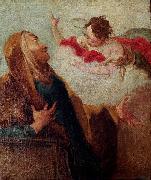 |
Francesco Maria Raineri -- Click Here
|
|
(February 2, 1676 - February 28, 1758) was an Italian painter of the late-Baroque, mainly active in Mantua.
Also called Lo Schivenoglia after the town, just outside of the city of Mantua, of his birth. He was a pupil of Giovanni Canti. Among his works, he was known for his paintings of battle scenes, landscapes, and cappriccios (vedute of imaginary scenes) with historical or mythologic figures. He was named director of the Academy of painters in Mantua in 1752. He is known to have painted a St. Sebastian for the chapel of Santa Anna. |
|
 |
Francesco di Giorgio Martini -- Click Here
|
|
Italian Early Renaissance Painter and Sculptor, 1439-ca.1501
was an Italian painter of the Sienese School, a sculptor, an architect and theorist, and a military engineer who built almost seventy fortifications for the Duke of Urbino. Born in Siena, he apprenticed as a painter with Vecchietta. In panels painted for cassoni he departed from the traditional representations of joyful wedding processions in frieze-like formulas to express visions of ideal, symmetrical, vast and all but empty urban spaces rendered in perspective. Francesco di Giorgio is also known for architectural designs and sculptural work for Federico III da Montefeltro, Duke of Urbino, for whom he built star-shaped fortifications. He composed an architectural treatise Trattato di architettura, ingegneria e arte militare that he worked on for decades and finished sometime after 1482; |
|
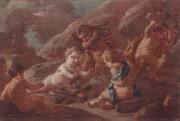 |
Francesco de mura -- Click Here
|
|
Italian Painter , b. 1696, Napoli, d. 1782, Napoli
was an Italian painter of the late-Baroque period, active mainly in Naples and Turin. His late work reflects the style of neoclassicism. He was a pupil of Francesco Solimena, then later with Domenico Viola, where he met his contemporary, Mattia Preti. While still in his teens he painted frescoes (1715) in San Nicola alla Carit?? in Naples. He painted ten canvases of the Virtues and an Adoration of the Magi (1728) for the church of Santa Maria Donnaromita. His other works include frescoes of the Adoration of the Magi (1732) in the apsidal dome of the church of the Nunziatella. |
|
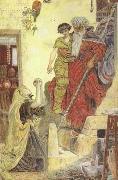 |
Ford Madox Brown -- Click Here
|
|
1821-1893
English painter and designer. The son of a retired ship's purser who had settled at Calais, Brown received an academic training under Albert Gregorius (1774-1853) at Bruges, under Pieter van Hanselaere (1786-1862) at Ghent and under Baron Gustaf Wappers at the Academie in Antwerp (1837-9). He moved to Paris in 1840, married the following year and studied independently of the ateliers |
|
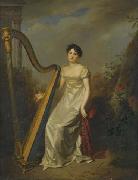 |
Firmin Massot -- Click Here
|
|
painted Portrait of a lady, wearing a white dress and seated beside a harp a landscape beyond in 1810 |
|
 |
Filip Andreevich Malyavin -- Click Here
|
|
Russian, 1869-1940 |
|
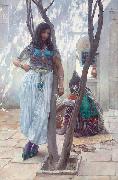 |
Ferdinand Max Bredt -- Click Here
|
|
painted In a courtyard, Tunis in 1921 |
|
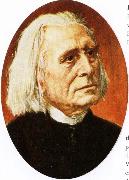 |
felix mendelssohn -- Click Here
|
|
Period: Romantic (1820-1869)
Country: Germany
Born: February 03, 1809 in Hamburg, Germany
Died: November 04, 1847 in Leipzig, Germany |
|
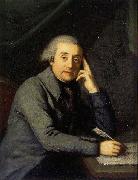 |
Felix Maria Diogg -- Click Here
|
|
(b Andermatt, 1 July 1762; d Rapperswil, Schwyz, 19 Feb 1834). Swiss painter. From 1782 he was a pupil of Johann Melchior Wyrsch in Besanion, under whom he developed the essential aspects of his portrait style. He also studied further in Rome and Naples from 1786 to 1788. He was capable of executing bright, incisive portraits in the manner of Angelica Kauffman, as in Portrait of an Artist or psychological studies, best seen in Ulysses von Salis-Marschlins. Several of his group portraits, such as the Esslinger Family, show the influence of Italian and British painting, with which he seemed to be familiar. He was a friend of Johann Kaspar Lavater, discoursed with Goethe and enjoyed the company of the Swiss historian Johannes von Miller (1752-1809), whose portrait he painted. His portraits are generally bust-length types set against a solid, dark background. This format was favoured by his Swiss clientele and is seen in Burgomaster Heinrich Krauer (1799; Lucerne, Kstmus.), which also reveals the dignified wooden pose frequently selected by his models. His direct, fashionable treatment of the sitter attracted a wide range of clients from all levels of society. He seemed to be as much at ease painting the Empress of Russia, Yelisaveta Alekseyevna (1814; Karlsruhe, Staatl. Ksthalle) as he was portraying the bourgeoisie of central Switzerland. |
|
|
|
|
| | |
|
|
|
|